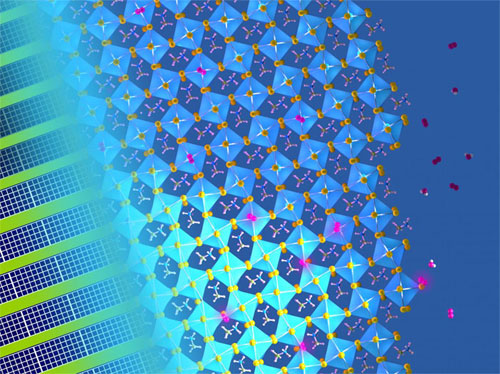CAMBRIDGE, England, Sept. 28, 2017 — Exposure to light combined with exposure to humidity and oxygen has been shown to permanently correct defects in the molecular structure of perovskites, resulting in minimal nonradiative losses and properties approaching those of perovskite single crystals and crystalline semiconductors.

The concoction of light with water and oxygen molecules leads to substantial defect-healing in metal halide perovskite semiconductors. Courtesy of Dr. Matthew T. Klug.
To repair defects caused by carrier trapping, a team of researchers from the University of Cambridge, MIT, Oxford University, University of Bath and Delft University of Technology developed a perovskite-based device, and before completing it, exposed it to light, oxygen and humidity.
When the light was applied, electrons bound with oxygen and formed a superoxide that could bind to electron traps and prevent these traps from hindering electrons. In the accompanying presence of water, the perovskite surface was converted to a protective shell. The shell coating removed traps from the surfaces and also locked in the superoxide, making the performance improvements in the perovskite permanent.
The team found that when humidity levels were between 40 and 50 percent, and exposure to humidity was limited to 30 minutes, degradation did not occur, even though perovskites often start to degrade in the presence of humidity.
Results showed that by combining light and atmospheric treatments, the internal luminescence quantum efficiencies of polycrystalline perovskite films could be increased from 1 percent to 89 percent, with carrier lifetimes of 32 microsiemens (μs) and diffusion lengths of 77 micrometers (μm) — an efficiency rate comparable with perovskite single crystals.
The surface recombination velocity of holes in the treated films came close to the values for fully passivated crystalline silicon, which has the lowest values for any semiconductor to date, according to researchers. These enhancements translated to solar cell power-conversion efficiencies of 19.2 percent, with a near-instant rise to stabilized power output.
“In perovskite solar cells and LEDs, you tend to lose a lot of efficiency through defects," said Sam Stranks, who led the research while he was a Marie Curie Fellow jointly at MIT and the University of Cambridge. “We want to know the origins of the defects so that we can eliminate them and make perovskites more efficient.”
Tiny defects (traps) in the crystalline structure of perovskites can constrict electrons before their energy can be harnessed for use by a solar cell. The more freely electrons can move around in the cell, the more efficient the cell.
“It’s counter-intuitive, but applying humidity and light makes the perovskite solar cells more luminescent, a property which is extremely important if you want efficient solar cells,” said Stranks. “We've seen an increase in luminescence efficiency from one percent to 89 percent, and we think we could get it all the way to 100 percent, which means we could have no voltage loss — but there’s still a lot of work to be done.”
The team’s work to date could lead to an industrially scalable method for treating defects in metal halide perovskite polycrystalline films, making their efficiency comparable to state-of-the-art semiconducting films. As an alternative to silicon-based solar cells, perovskites are inexpensive and easy to produce.
The research was published in Joule (doi: 10.1016/j.joule.2017.08.006).